
It’s an ambitious plan to launch a series of micro-spaceships to our stellar neighbours, but that’s what Russian billionaire Yuri Miller has announced this week. The US$100m Breakthrough Starshot project aims to send the probes out at speeds up to about one fifth the speed of light.
British theoretical physicist Stephen Hawking and Facebook’s Mark Zuckerberg have backed the project to see what is around our nearest stars.
But is this possible with today’s technology or even technology in the near future?
The Breakthrough Starshot project admits there are a “number of hard engineering challenges” but it adds:
In the last decade and a half, rapid technological advances have opened up the possibility of light-powered space travel at a significant fraction of light speed. This involves a ground-based light beamer pushing ultra-light nanocrafts — miniature space probes attached to lightsails — to speeds of up to 160m kilometres an hour.
Such a system would allow a flyby mission to reach Alpha Centauri in just over 20 years from launch, and beam home images of possible planets, as well as other scientific data such as analysis of magnetic fields.
The nearest star to our sun is Alpha Centauri, which is just over four light years away (about 40 trillion kilometres). It would take 70 000 years to reach that star system at the speeds of current spacecraft like Nasa’s Voyager, which left our solar system in 2012.
But then each of the two Voyager probes are about the size of a small car with a mass of more than 700kg.
The idea behind an interstellar micro-spaceship is that it is very light, so the overall energy required to accelerate it to 20% of the speed of light is relatively small.
Modern miniaturisation of electronics makes it possible to fit much of what is needed for an unmanned spaceship in a very small volume.
These craft would be too small to carry their own engine and propellant tank. Hence the idea to accelerate them on their journey using a series of lasers on earth with a small solar sail on each craft to capture the laser energy.
But the jury is out on whether this is physically achievable.
Hurdles
There are still many technical hurdles to overcome. For one, the laser propulsion system is yet to be developed.
The plan is to have a kilometre-sized array of lasers pointing up into space and all focused on the gossamer thin solar-sails. But how much laser power are we really talking about?
Let’s do some simply numbers. The power required to accelerate a 1g spaceship to 20% of the speed of light in two minutes is 15GW. This is 30 times the power output of a typical terrestrial power station.
What about acceleration? We all know the feeling of a car accelerating quickly. We usually compare the level of acceleration to that of gravity, which is the acceleration we see when an object is dropped from a tower.
The acceleration needed for the microships is 25 000 times gravity. The loads from this acceleration would break apart even the strongest space capsule, let alone a gossamer-thin solar sail.
Another issue is how to make sure the microship goes where you want it to — in this case towards Alpha Centauri.
But there would be no on-board propulsion system, so no corrections to the flight direction can be made along the way. The initial laser push would need to be very accurate and would need to account for many affects, just like a golfer trying to hit a hole-in-one must account for the wind.
Then there would be the very harsh interstellar environment between Earth and the final destination. So the on-board electronics would have to be tough enough to survive this environment for at least 20 years.
What about when it gets there? As the micro-spaceships will be so far away, the engineers on earth will have to wait years to make contact with it. So it would have to be autonomous and be able to make its own decisions.
I am sure the planners have also thought about what the ship should do if it encounters another civilisation!
Despite all the challenges and technical difficulties, who knows what human ingenuity can create when given a challenge.![]()
- Michael Smart is professor of hypersonic aerodynamics, University of Queensland
- This article was originally published on The Conversation

